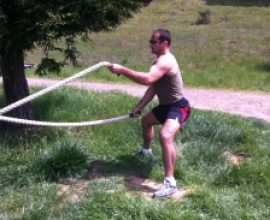Sep 14, 2011
2eagles
Fitness, Functional Fitness, personal trainer, Workout Wednesday 0 comments
energy systems, fast glycolosis, glycolactic, lactate threshold, oxidative, phosphagen, slow glycolosis, Workout Wednesday
[wpvideo UjIuXY0s]Did you know you can exercise in four different energy systems?
The best trainers emphasize each of the four energy systems–even though all four work together–to increase power, endurance, and rate of recovery. The quicker you recover, the more fit you are.
What are they called?
- The most powerful energy system characterized by things like sprinting, resistance band running, long jump, shot put, golf wind, or javelin throw. 0-6 seconds of pure teeth clenching power fueled by creatine phosphate and adenosine triphosphate.
-
FAST GLYCOLOSIS: 30-90 seconds of unbroken work such as sit-ups, push-ups, pull-ups, and a 500 meter row encompass this energy system fueled by blood glucose. Fast glycolosis is crucial to train because it’s anaerobic and produces a muscle burn called lactate. Hitting the lactate threshold enables us to reach our fitness goals by pushing us to the max in order to go even farther at the next session.
-
 SLOW GLYCOLOSIS: 2-5 minutes of continuous work in the form of planks, 1000 meter row, half mile run, jump rope, or plyometric work fueled by glucose in the form of stored glycogen. Aerobic so it does not produce lactate.
SLOW GLYCOLOSIS: 2-5 minutes of continuous work in the form of planks, 1000 meter row, half mile run, jump rope, or plyometric work fueled by glucose in the form of stored glycogen. Aerobic so it does not produce lactate.
-
OXIDATIVE:
-
Any activity lasting longer than 5 minutes from a five-minute swim to a 26.2 mile marathon. Fueled by glycogen, glucose from fatty acids and amino acids, the oxidative system also controls recovery. Most of our daily activities and the steady state cardiovascular work everyone loves like running, biking, swimming, and walking all occur in the oxidative system. While it’s important, it’s also the comfort zone. It’s easier to run at the same pace for thirty minutes than it is to string together a twelve-minute circuit combining the phosphagen, fast and slow glycolosis systems. We don’t want EASY we want maximum EPOC!
Which energy system is Beqir using in this video?
Related Posts
Motivational Monday: Revenge of The Trainees
While the profits of having a personal trainer far outweigh the losses, clients sometimes dream of the day the...
Apr 09, 2012 / 0 comments
Motivational Monday: Sugary, Salty, and Creamy
Weight loss and learning to live a healthy lifestyle requires serious palate re-training. American palates ar...
Dec 05, 2011 / 0 comments
Motivational Monday: New Website!
What motivates more than a brand new website? Haven’t seen it yet? What are you waiting for? Now that yo...
Apr 30, 2012 / 0 comments
Motivational Monday: Vision & Choice
Monday is upon us again. Everyone needs a little boost for the week ahead. So let’s start with the big...
Aug 22, 2011 / 0 comments



